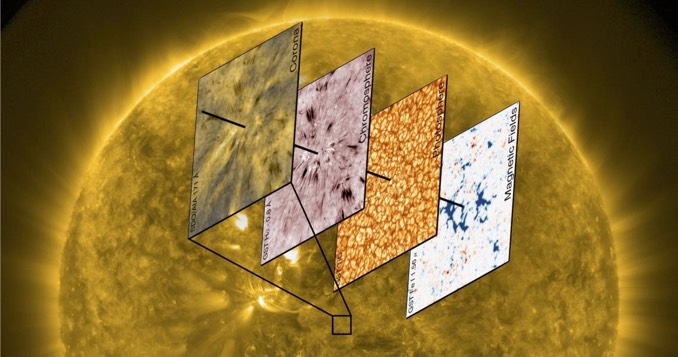
An international team of scientists, including three researchers from New Jersey Institute of Technology (NJIT), has shed new light on one of the central mysteries of solar physics: how energy from the Sun is transferred to the star’s upper atmosphere, heating it to 1 million degrees Fahrenheit and higher in some regions, temperatures that are vastly hotter than the Sun’s surface.
With new images from NJIT’s Big Bear Solar Observatory (BBSO), the researchers have revealed in groundbreaking, granular detail what appears to be a likely mechanism – jets of magnetised plasma known as spicules that spurt like geysers from the Sun’s upper atmosphere into the corona.
In a paper published in the journal Science, the team describes key features of jet-like spicules that are in solar terms small-scale plasma structures, between 200 and 500 kilometres wide, that erupt continuously across the Sun’s expanse. The researchers also, for the first time, show where and how the jets are generated and the paths they travel, at speeds of around 100 kilometres per second in some cases, into the corona.
“Unprecedented high-resolution observations from BBSO’s Goode Solar Telescope clearly show that when magnetic fields with opposite polarities reconnect in the Sun’s lower atmosphere these jets of plasma are powerfully ejected,” said solar physicist Wenda Cao, BBSO’s director and an author of the paper.
He added, “This is the first time we’ve seen direct evidence of how spicules are generated. We have tracked these dynamic features in the H-alpha spectral line down to their foot points, measured the magnetic fields at their foot point, captured the migration of the emerging magnetic elements and verified their interaction with existing magnetic fields of the opposite polarity.”
Images captured in the extreme ultraviolet (EUV) spectrum by NASA’s Solar Dynamics Observatory spacecraft were used to track the transportation of energy in the corona. These observations showed that it is also common for spicules to be heated to typical coronal temperatures.
Invisible to the human eye except when it appears briefly as a fiery halo of plasma during a solar eclipse, the corona remains a puzzle even to scientists who study it closely. Beginning 1,300 miles from the star’s surface and extending millions more in every direction, it is more than a hundred times hotter than lower layers much closer to the fusion reactor at the Sun’s core.
Scientists from the Max Planck Institute for Solar System Research in Germany, NASA’s Marshall Space Flight Center, the University of Sheffield in the U.K., Eötvös University in Hungary, Kunming University of Science and Technology in China, the University of Graz in Austria and Indian Institute of Astrophysics all played roles.



